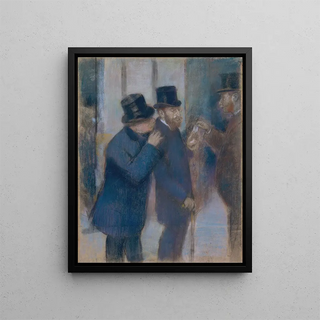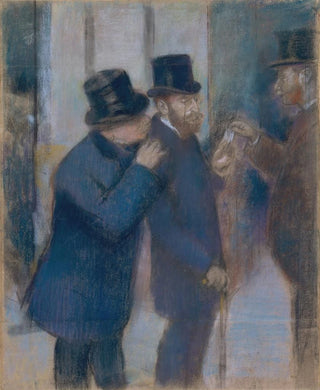Art print Portraits à la Bourse (Conflit de cas) - Edgar Degas | Art print


View from behind

Frame (optional)
An art print of Portraits at the Bourse (Conflict of cases) - Edgar Degas – Captivating introduction
In the fascinating universe of art, some works transcend their era and capture the very essence of human life. "Portraits at the Bourse (Conflict of cases) - Edgar Degas" is one such creation. This painting, emblematic of realism and impressionism, immerses us in the heart of a lively scene where the observation of social behaviors blends with refined pictorial technique. Through this masterpiece, Degas invites us to explore the subtleties of human interactions while offering a window into Parisian society of the 19th century. The depiction of the characters, their expressions, and postures evoke a palpable dynamic, making this work both timeless and decidedly modern.
Style and uniqueness of the work
Edgar Degas's style is renowned for its ability to capture movement and life in his paintings. In "Portraits at the Bourse (Conflict of cases)", the artist uses bold brushstrokes and contrasts of light to create a vibrant atmosphere. The characters, although frozen in time, seem animated by a palpable tension, as if they are about to engage in a conversation or debate. The meticulous details of clothing and faces testify to attentive observation and a deep understanding of psychological nuances. Degas does not merely depict his subjects; he interprets them, revealing their hidden emotions and motivations. This painting is thus a perfect example of his unique style, where realism blends with an almost impressionist approach, creating a work rich in emotions and meanings.
The artist and his influence
Edgar Degas, a major figure of the Impressionist movement, distinguished himself with his innovative approach to painting. Born in 1834 in Paris, he dedicated his life to exploring the human condition through art. Although often associated with ballet scenes and urban life, his work goes far beyond these themes. Degas captured the complexity of human relationships, emotions, and social tensions, offering a profound reflection on the society of his time. His influence extends well beyond

Matte finish

View from behind

Frame (optional)
An art print of Portraits at the Bourse (Conflict of cases) - Edgar Degas – Captivating introduction
In the fascinating universe of art, some works transcend their era and capture the very essence of human life. "Portraits at the Bourse (Conflict of cases) - Edgar Degas" is one such creation. This painting, emblematic of realism and impressionism, immerses us in the heart of a lively scene where the observation of social behaviors blends with refined pictorial technique. Through this masterpiece, Degas invites us to explore the subtleties of human interactions while offering a window into Parisian society of the 19th century. The depiction of the characters, their expressions, and postures evoke a palpable dynamic, making this work both timeless and decidedly modern.
Style and uniqueness of the work
Edgar Degas's style is renowned for its ability to capture movement and life in his paintings. In "Portraits at the Bourse (Conflict of cases)", the artist uses bold brushstrokes and contrasts of light to create a vibrant atmosphere. The characters, although frozen in time, seem animated by a palpable tension, as if they are about to engage in a conversation or debate. The meticulous details of clothing and faces testify to attentive observation and a deep understanding of psychological nuances. Degas does not merely depict his subjects; he interprets them, revealing their hidden emotions and motivations. This painting is thus a perfect example of his unique style, where realism blends with an almost impressionist approach, creating a work rich in emotions and meanings.
The artist and his influence
Edgar Degas, a major figure of the Impressionist movement, distinguished himself with his innovative approach to painting. Born in 1834 in Paris, he dedicated his life to exploring the human condition through art. Although often associated with ballet scenes and urban life, his work goes far beyond these themes. Degas captured the complexity of human relationships, emotions, and social tensions, offering a profound reflection on the society of his time. His influence extends well beyond
12,34 €






